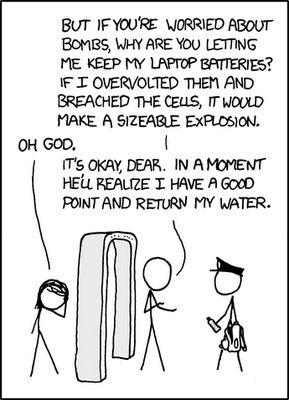 The Northwest Airlines Flight 188 debacle gave us the opportunity to examine whether the communications between the air defense officials and air traffic controllers have improved much since 9/11. They haven’t.
The Northwest Airlines Flight 188 debacle gave us the opportunity to examine whether the communications between the air defense officials and air traffic controllers have improved much since 9/11. They haven’t.
What about on the ground?
When we go to the airport, we’ve been taking off our shoes, stashing our mouthwash, and dragging our handicapped parents out of their wheelchairs long enough that the Transportation Security Administration procedures almost seem normal; they almost make sense.
Almost.
The Atlantic’s James Fallows calls our attention this afternoon to a General Accounting Office assessment of the Transportation Security Administration.
The GAO report found that the security checkpoint procedures don’t match the relative risk, GAO-speak for “they don’t make any sense.”
From time to time, we hear about new technologies to make getting through security easier. In fact, after 9/11, a Minnesota firm’s facial-recognition software was supposed to be one of the next big things. It failed.
In fact, the GAO notes, the Department of Homeland Security has invested $795 million in technologies to screen passengers at airport checkpoints since 9/11. Since TSA was created, 10 passenger screening technologies have been in various phases of research and development.
How many have been deployed over that time and at that cost? None.
“The ongoing impossibility of applying logic to this situation really is discouraging — or, more positively, is an opportunity for someone in government to address,” Fallows writes.
By the way, the TSA has a response to the cartoon above:
The batteries may be more dangerous than a bottle of water, but they are not more dangerous than a water bottle filled with liquid explosives.
Find the whole post here. Feel free to share your going-through-security story below.
Comic: xkcd
